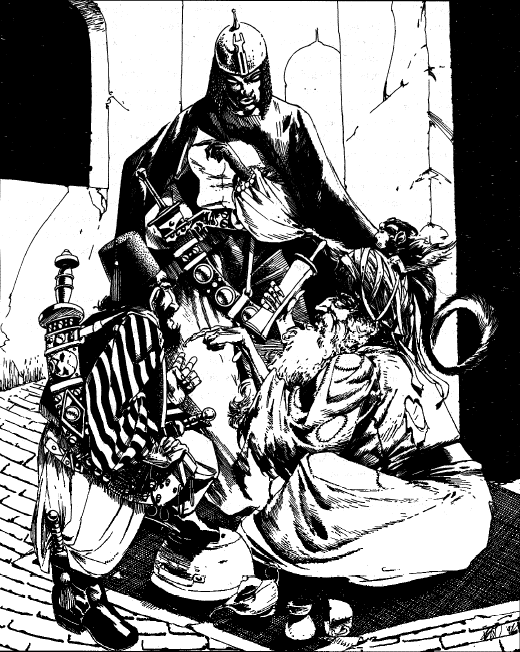What Do the Monsters Want?
December 14, 2017 rpgs dnd tables monsters ophanim
One of my favorite tools in D&D is the Reaction table. It’s incredibly simple (three sentences of description) and if you want, it can adjudicate almost every social encounter the PCs run into in a game. I’ve written before that I can get biased against the players over time. You’re seeing all their crazy hijinks and ridiculous plans go sideways, it’s only natural to imbue all your NPCs with a kind of removed skepticism that causes them to never react positively towards the PCs. The reaction table fixes that.
Monster Reactions
MONSTER ACTIONS: Some monsters always act in the same way (such as zombies, who always attack). However, the reactions of most monsters are not always the same. The DM can always choose the monster’s reactions to fit the dungeon, but if he decides not to do this, DM may use the reaction table below to determine the monster’s reactions (roll 2d6).
Dice Roll Reaction 2 Immediate Attack 3-5 Hostile, possible attack 6-8 Uncertain, monster confused 9-11 No attack, monster leaves or considers offers 12 Enthusiastic friendship – Dungeons & Dragons Basic Rulebook, pg. B24
Players with higher charisma get a bonus to rolling on this table, which makes charisma absolutely not a dump stat in the older versions of the game (although, even the concept of a dump stat doesn’t play when you’re rolling 3d6 straight down the line). If you roll for reaction at every encounter, combat only immediately breaks out 3% of the time, which is amazing if you’re running a more dangerous game. Combat can be avoided in almost every situation.
However, the hardest part for me of the reaction table is rolls between 6-8. Possibly just out of habit, reactions often spiral down quickly into combat. “Oh they’re confused, so they yell at you and now uh roll initiative.”
 From ALQ1: Al-Qadim Golden Voyages
From ALQ1: Al-Qadim Golden Voyages
What Do the Monsters Want?
So what I have here is an addition to the reaction table for you to use. D10 things that the monsters could want. There’s a lot of ways to use this, PCs can be bargaining with the monsters and knowing what the monster wants can be something for the PCs to figure out, or it can just be something the monster demands or else they attack (like say, on a roll of 3-5 on the reaction table). But with this, a wandering monster table, and a reaction table, your random encounters should have a lot more life.
| Roll | What They Want | Description |
|---|---|---|
| 1 | Food | They’re hungry. You can distract them with rations, point them towards corpses, cast a food illusion. They could be hurt and need healing. |
| 2 | Gold | They want d100 gold X their HD. This could be a tax, a toll, tribute, tithe, or they could just be greedy bastards, or easily distracted by shiny baubles. |
| 3 | Treasure / Magic Items | They want a number of items equal to their HD. Scrolls and potions count here as well. |
| 4 | Random Item | Roll a random item from a random PCs sheet, they want that for some reason. |
| 5 | Territory | This is their territory, they will defend it, but mostly they just want you to leave or prove why you should be able to pass through. |
| 6 | Information | They want to know about a rival faction, nearby NPC or monster, or dungeon landmark or location. |
| 7 | Help | They need something from further in the dungeon, or from a nearby wilderness hex. They may want you to kill other monsters in the dungeon or clear out a hex. They may be haunting the area and can only leave when their quest is fulfilled. |
| 8 | Trade | They have a random item from each category on the equipment list (one piece of armor, one weapon, one piece of equipment, etc.) and they’re willing to trade those items or save them. All trades made inside the dungeon are at a higher markup than you’ll find in town. |
| 9 | To Complete a Mission | They’re in service to the closest NPC in the dungeon and whatever that NPC wants, this monster is on a mission to help achieve that aim. |
| 10 | Directions | They’re lost and are looking for directions out, or for someone to escort them to a safe area. |
Previous post
D20 Quick Cleric ReligionsNew clerics in my games roll on the following table and develop the religion as they see fit. Notes on their religion are passed down to future...
Next post
Battletech: FAL-5A FalstaffI just grabbed a copy of Battletech 2nd Edition off of eBay. It’s a game that I’ve wanted to try out for a long time, and since from what I’ve read...
Copyright © 2018 Failure Tolerated